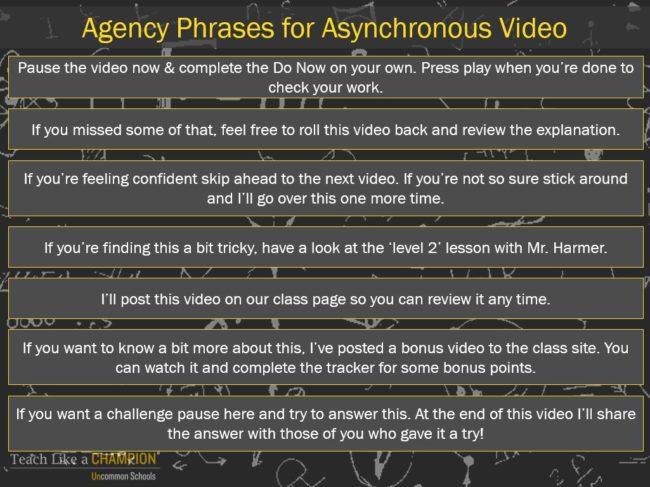08.24.20Agency Over Video: The Key to Asynchronous Instruction
Good online instruction will probably always involve a combination of synchronous and asynchronous methods. After all they have different strengths and limitations. Synchronous instruction allows us to connect with students and build relationships. And it lets us understand and support their learning in real time. But asynchronous instruction deals better with technology problems: it resists glitchy internet access. Because you can watch any time it’s helpful when you’ve got a household with one laptop and three kids trying to use it.
So what’s the key to effective asynchronous lessons? You can see one of the big ones in action in the first seconds of this lesson by Joshua Humphrey:
Thirty seconds into the video he’s signaling that asynchronous lessons are an active experience for students. Pause this video and complete your DO Now. Students–no, people, assume that video equals passive content. You press play and then it washes over you. You have no agency. Joshua’s message is: you will engage with this video. You control it.
You can see that theme expressed here too, in a different way:
In this video Chloe Hykin reminds her students that if they are struggling they are in charge. They might re-watch an explanation or–as she suggests here–watch a special video designed to give a more in depth explanation to those who find it tricky. Over and over she reminds students: you own this. You have control.
In this video Denise Karratti makes that process even more explicit.
This is a beginning of the year video and making an “introduce yourself to the class” video. But at the end you can see she’s also building the mindset among students: be an active not a passive consumer of all the videos this year. If you feel information overload go back and re-watch.
This in fact is one of the few small silver linings of online teaching. It’s often easier to go back and review–or skip ahead to more advanced work–than it might be in a typical classroom.
The theme here is agency. You own this video. You must watch it in the way that supports your own learning. There are in fact, dozens of ways you could encourage students to exert agency. This slide shows you a few examples of how that might sound.

